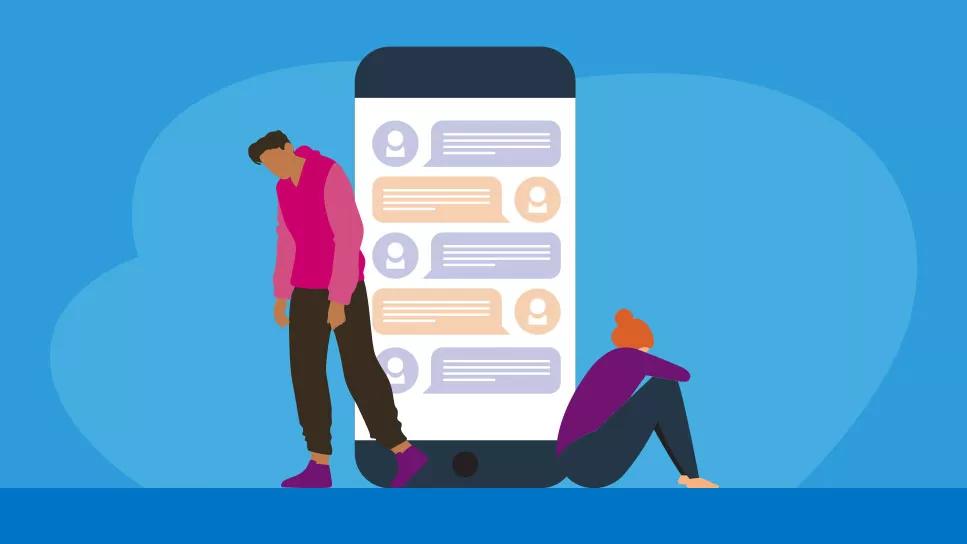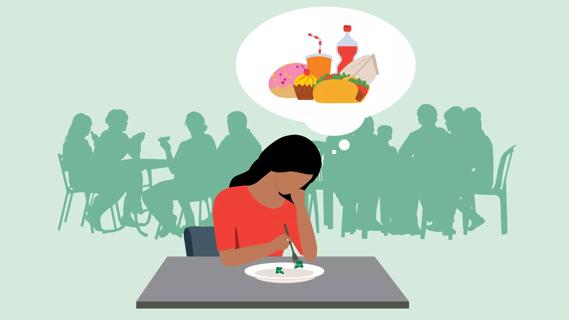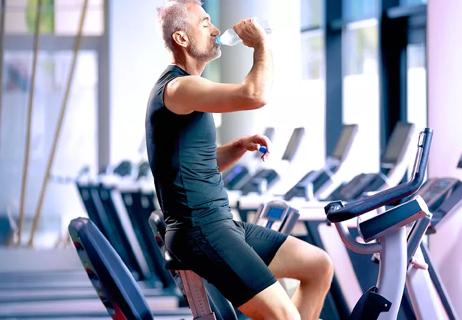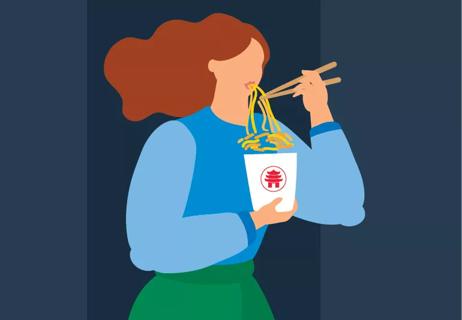While social media content doesn’t create eating disorders, it can easily exacerbate them

We all have bad body image days. Your hair did that thing you hate or that one weird pimple on the tip of your nose just won’t go away. You’re reeling from a breakup or that ankle injury has left you sidelined from your daily 30-minute walk. And your co-worker said something passive-aggressive about your lunch to boot!
Advertisement
Cleveland Clinic is a non-profit academic medical center. Advertising on our site helps support our mission. We do not endorse non-Cleveland Clinic products or services. Policy
You’re usually pretty comfortable in your own skin. But today … today, you aren’t feeling great.
So, you escape into social media for a while. Then, you see it: A dramatic before and after picture. The caption: “Skip dinner. Wake up thinner!” It sends you down a rabbit hole of posts about radical weight loss and the “skinny lifestyle.”
By the time you log off, you’re feeling pretty unsure about yourself. In the back of your mind, the thought marinates: “Maybe it really is time to start skipping meals.”
What just happened?! You just got hooked by something called “thinspo.” The people behind it may not have had malicious intent, but their posts are designed to capitalize on your feelings of self-doubt and dissatisfaction, playing a dangerous game.
Psychologist Susan Albers, PsyD, explains what thinspo is, why it’s dangerous, and how to keep yourself and your loved ones safe.
“Thinspo” is short for “thinspiration,” which combines the words “thin” and “inspiration.” Dr. Albers says thinspo refers to any kind of media that encourages an unhealthy body image or disordered eating. You’re most likely to encounter thinspo on social media. What makes it so dangerous, though, is the fact that you might not realize what you’re seeing. It may seem helpful and legitimate.
Advertisement
“The part that’s the most disturbing, as a professional and a parent, is that it can be very subtle,” Dr. Albers says. It frequently masquerades as health information or self-help style advice.
“Because our understanding of healthy foods and dieting is so skewed by diet culture, we may struggle to recognize thinspo for what it is,” she notes. “We don't see it coming, so it can show up very innocently on our feed and suck us in.”
But thinspo isn’t always subtle. Sometimes, it’s shocking. We’re talking pictures of people on the verge of starvation. We’re talking online communities that claim anorexia nervosa is a “lifestyle,” not the serious medical condition it is. We’re talking about people sharing tips to avoid getting caught engaging in disordered eating behaviors.
“Thinspiration” and “thinspo” started as (and remain) popular hashtags that devotees use to collect content. Luckily, some social media companies are beginning to realize the power it has — especially on teenagers and people living with or recovering from an eating disorder.
These days, if you search “#thinspo” on Instagram, you’ll get re-routed to a screen asking “Can we help?” Among the resources provided are the hotline and website information for the National Alliance for Eating Disorders.
It’s a commendable move, but it’s a drop in the bucket. Diet culture is all around us, and you don’t have to search “#thinspo” to get mired in the stuff. There’s a lot out there that fits under the thinspo umbrella. Here are some of the most common genres you’ll encounter online.
You’ve probably read articles and seen videos like this. They usually feature a wealthy and conventionally attractive (thin) person — sometimes, a celebrity — taking the audience through their daily routine and eating habits. At least, they claim that’s what they’re doing.
The routine tends to be unrealistic, and so is the food. Meals are usually either entirely homemade (no store-bought ketchup here!) or ordered at a trendy restaurant. The ingredients used in each dish tend to be exotic and expensive, and the portion sizes are often inadequate.
“‘What I Eat In A Day’ videos foster comparisons,” Dr. Albers says. “They also suggest that this is what you should be eating. Everyone has different nutritional needs, so that message can be dangerous.”
Unlike some of the other types of content we’re mentioning here, body checking isn’t specific to thinspo. It’s a common behavior. Basically, Dr. Albers explains that body checking is habitually seeking information about your body. That’s not a bad thing. But it can become compulsive, especially for people experiencing any kind of body dysmorphia.
Advertisement
Body checking thinspo content frequently involves before-and-after videos and weight-loss montages. You might also see people talk about the parts of their bodies they dislike, post photos of themselves they consider unflattering or share images of what they consider to be an ideal body. That kind of content promotes objectification and body shaming.
“It really boils down to comparing yourself, either to a different, idealized image of yourself or to other people,” Dr. Albers further explains. “That comparison can be very toxic and skew your perception of yourself.”
This one’s a bit counterintuitive. “Cheat day” videos feature people taking a “day off” from their usual (disordered) food and fitness routines to spend hundreds of dollars eating thousands upon thousands of calories. They sometimes go so far as to include a morning and evening weigh-in, just to drive home how much food they’ve eaten.
Right now, you might be thinking, “That doesn’t really sound like a normal cheat day. It sounds like bingeing.” And you’re right about that. It is binge eating. These videos promote thinness and muscularity by suggesting (incorrectly) that — if you lose enough weight — you’ll eventually be able to eat unhealthy quantities of whatever food you want. That simply isn’t true.
Advertisement
“It also implies that there are hard and fast rules around food and that breaking them is bad,” Dr. Albers adds.
According to Dr. Albers, “reverse thinspo” can be just as damaging as the regular kind.
In reverse thinspo, you watch people — often people who have overweight or obesity — eat large quantities of foods containing fat, sugar and salt. The goal is to shame people living in larger bodies and promote disgust in the viewers.
“It’s considered a form of thinspo because it inspires people not to eat,” Dr. Albers clarifies.
This corner of the thinspo universe may be the deadliest.
“Pro-ana” stands for “pro-anorexia.” “Pro-mia” is “pro-bulimia.” The people creating pro-ana and pro-mia content argue that disordered eating isn’t a mental health concern — it’s a “lifestyle.” They build communities of people who see life-threatening weight loss and undernutrition as the beauty ideal and encourage each other to engage in dangerous weight loss behaviors.
These spaces often become competitive, with community members comparing weight loss and challenging each other to restrict their food intake further and further.
Perhaps most unsettling, pro-ana and pro-mia content often involves tips and tricks for hiding those behaviors from one’s family and friends.
Advertisement
While many social media platforms have banned this material, some still allow it. And these communities adapt quickly to get around bans.
By now, you’re probably realizing that there’s a lot of thinspo out there. Does any of it actually help people get healthier?
Dr. Albers says it doesn’t.
“Thinspo ultimately doesn’t work because it’s based on shame and feeling bad about yourself,” she stresses. She adds that, according to psychological research, we’re most motivated by positive reinforcement, and messages designed to make us feel good.
“When we feel shame,” she continues, “we shut down.”
Another reason thinspo is ineffective: It’s not really about health, at the end of the day.
“What gets lost in thinspo content is the reality that healthy bodies come in all shapes and sizes,” Dr. Albers says. “We all have different bodies, and being healthy doesn’t look the same for everyone. Thinspo is rooted in diet culture and the idea that it’s all about being thin.”
Even if you do fit into the narrow standard of beauty that thinspo celebrates, nobody wants to feel like their value hinges on their appearance. And fitting into the thinspo aesthetic doesn’t banish insecurity either because thinspo is all about fixing the next “flaw.” And the next. And the next. Self-love and self-esteem are the enemies of thinspo content.
According to Dr. Albers, thinspo is highly correlated with poor body image and a lack of self-confidence. A 2018 study found that being exposed to thinspiration exacerbated symptoms in people living with eating disorders.
But we’re exposed to body-shaming media every day. What makes thinspo so uniquely threatening to our mental, physical and emotional health? It might have something to do with the fact that you can access much more extreme images and messages on social media than you’d typically encounter during your everyday life.
“Some of those images can’t be erased. And some of the phrases get stuck and repeat in people’s heads,” Dr. Albers explains. “People sometimes tell me about thinspo that they saw 20 years ago that they’re still replaying.”
People who’ve never experienced an eating disorder or body dysmorphia may not realize exactly how hard it can be to recover. You aren’t just trying to change eating habits: You’re consciously rejecting thought patterns that feel right. Thinspo is dangerous because it validates that feeling.
“I’ve seen it in clinic: While they might not always realize it, people are often looking for triggers that will allow them to maintain the disorder, and thinspo is a way to fuel it,” Dr. Albers shares.
“It’s kind of a chicken-and-egg question,” she continues. “Does thinspo worsen the mental health issue, or does the mental health issue worsen the compulsion to seek out thinspo? It can go both ways.”
“People have varying degrees of susceptibility to thinspo,” Dr. Albers says. “Anybody can be affected. Nobody is immune to it. But some people are more vulnerable because of body image history, trauma or mental illness, while others are more able to filter it out.”
The following are just a few conditions that Dr. Albers says thinspo can exacerbate:
If you’re already struggling with mental health concerns, thinspo can trigger relapses into self-destructive behaviors like obsessive body checking and encourage unhealthy thought patterns.
“People are very impacted by thinspo,” Dr. Albers laments. “It really sticks like glue in your head.
The concept of thinspo has been around for a while now, but it’s been back in the news recently thanks to artificial intelligence (AI).
In a 2023 article in The Washington Post, columnist Geoffrey A. Fowler shared his disturbing experiences with generative AI programs creating thinspo content on command. He got everything from tips to induce vomiting to weight loss meal plans from AI bots. They generated plenty of disturbing images, too. Fowler wrote, “AI has learned some deeply unhealthy ideas about body image and eating by scouring the internet.”
Dr. Albers agrees. She’s particularly concerned about image generators. The physiques AI bots produce are often impossible to attain and can feed body dysmorphia.
“People of all sexes — and particularly adolescents — are very susceptible to these images,” she says. “I think AI is going to open up a whole new world of thinspo, in a negative way.”
Creating and maintaining a positive body image is no mean feat. We all get messages — both overt and covert — that our value is linked to our appearance. But we can escape from those forces and cultivate self-love. It’s not easy, but it’s possible.
Dr. Albers shares a few tips for dealing with — and disengaging from — thinspiration.
“It’s easy to mindlessly scroll through your social media feeds and not think about what you’re seeing on a deeper level,” Dr. Albers realizes. But spotting thinspo and recognizing the subliminal (and not so subliminal) messages it’s trying to send can make it less powerful.
Grounding yourself in the real world also makes it easier to recognize social media for what it is.
“So much of social media is fake,” Dr. Albers stresses. “Recognize that you might be looking at an altered image or a picture taken from a particularly flattering angle. Social media is really curated, so don’t treat the images you see as facts.”
The opposite of mindless scrolling is mindful scrolling. That means staying in the moment (and staying in touch with your feelings) as you engage with potentially troubling content.
“Ask yourself how the content you’re engaging with makes you feel,” she suggests. “If it drags down your self-esteem, you know that it may be related to thinspo.”
Not all content related to weight, food or fitness qualifies as thinspo. Far from it. If you want to learn about those topics, seek out evidence-based health information.
It can be hard to avoid diet culture on social media, but there are plenty of creators out there who are pushing back against it. Body positivity and body neutrality are gaining momentum, leading to a growing understanding that bodies come in all shapes and sizes — and that every body is valid, beautiful and worth celebrating.
“If looking at a post, picture or video makes you feel motivated without feeling shamed, it’s probably on the healthier end of the spectrum,” Dr. Albers says.
Do what you can to filter thinspo out of your social media feeds.
“Unfollow anything that resembles thinspo,” Dr. Albers urges. “If you see something related to disordered eating, dieting or a negative body image, turn away from it.”
If you can’t shut it out, Dr. Albers recommends looking past first impressions and thinking critically about what you’re seeing. Ask yourself how it’s an example of diet culture and how you’re supposed to feel looking at it. Dr. Albers has noticed that breaking thinspo down in this way is helpful, especially for people who have — or have a history of — disordered eating patterns.
Dr. Albers warns against “the comparison trap” for many reasons.
Comparing yourself to other people is always an unhealthy habit. But comparing yourself to social media content may be even worse. That’s because when we compare ourselves to the people we see in thinspo content, we’re not actually comparing ourselves to other people. We’re comparing ourselves to a carefully curated image of “the skinny lifestyle.”
Perception is not reality. And in the case of thinspo, the perception is designed to evoke feelings of shame. That can lead to negative self-talk.
Celebrating other people and wanting good things for them, instead of feeling threatened by them, is a healthier, happier way to live.
“When you stop comparing yourself to other people, that shuts down a lot of the need for thinspo,” Dr. Albers says.
Dr. Albers recommends putting pen to paper and listing the things you like about yourself that have nothing to do with your appearance. By focusing on your character instead of what you see in the mirror, you can start to slowly adjust your frame of mind and build your self-esteem.
Conversations that revolve around weight and weight loss can be hard to avoid. But Dr. Albers says it’s crucial — not just for your mental health, but also for the mental health of the people around you.
“Avoid making any comment on other people’s bodies, positive or negative,” she advises. Focus instead on what really matters. It makes for much more interesting conversations. And let’s be real: Creative compliments are the best compliments.
Dr. Albers adds that it’s important to be honest with yourself about the thinspo you’re engaging with and the impact it’s having on you. Here are a few warning signs that thinspo has become problematic for you:
If you realize your interaction with thinspo is becoming unhealthy, Dr. Albers recommends meeting with a licensed, professional therapist to discuss it.
Thinspo (thinspiration) — media that glorifies being thin or having any degree of underweight — is biased against and sometimes actively shames people who have overweight or obesity. And it promotes a poor body image and disordered eating.
While a lot of thinspo messaging is implicit and hard to recognize, there’s also thinspo that explicitly targets vulnerable populations, as well as advocating for and facilitating eating disorders.
But disordered eating is a complex phenomenon, and thinspo can’t be held solely responsible for those behaviors developing. Ditto with relapsing. Still, it’s an incredibly dangerous trigger for teenagers and people in recovery.
While some people are more sensitive to thinspo than others, we’re all susceptible to body-shaming rhetoric. Learning how to identify it, remove it from view and cultivate a positive body image is an important form of self-care. Remember: Inspiration shouldn’t hurt. Motivation is a positive feeling, so seek out people and content that make you feel good about yourself.
Learn more about our editorial process.
Advertisement

An obsession with eating ‘clean’ or ‘healthy’ can be both physically and emotionally damaging

Eating disorders are diagnosable mental health conditions, while disordered eating is unhealthy eating behavior that doesn’t meet the criteria for a diagnosis

This is an eating pattern that doesn’t meet the criteria for an eating disorder but can still be harmful

Having overweight and disordered eating is a high-risk combination that often gets dismissed or overlooked

Get moving, avoid the scale and be kind to yourself — plus, learn your triggers

It may be mistaken for digestive problems

Don’t let emotions trigger bad food habits

They cause junk food cravings at night

Babies can get congested easily, but you can calm their cough by keeping them hydrated, using nasal drops and running a humidifier

Weight loss may cause loose, sagging skin and muscle loss to your rear

Several conditions, like vitiligo and fungal infection, can cause a loss of pigmentation, leading to white spots or patches on your skin